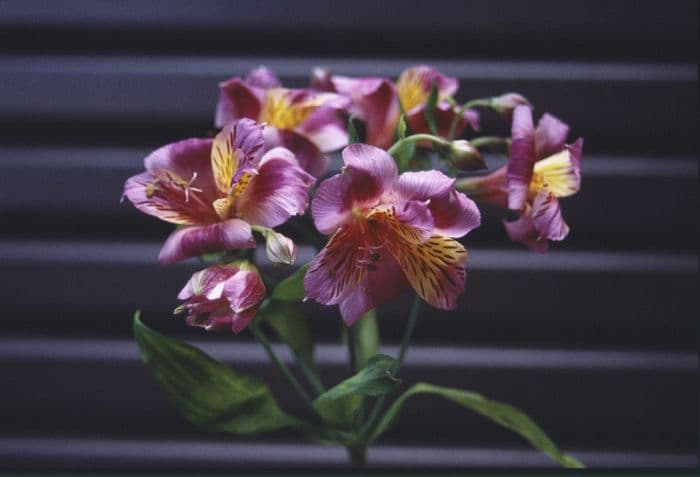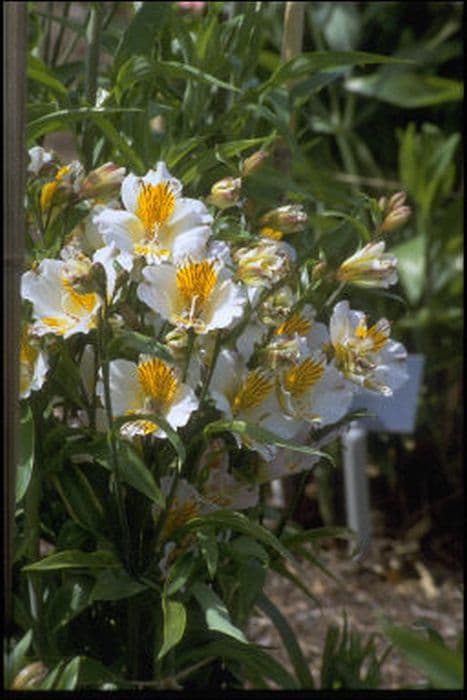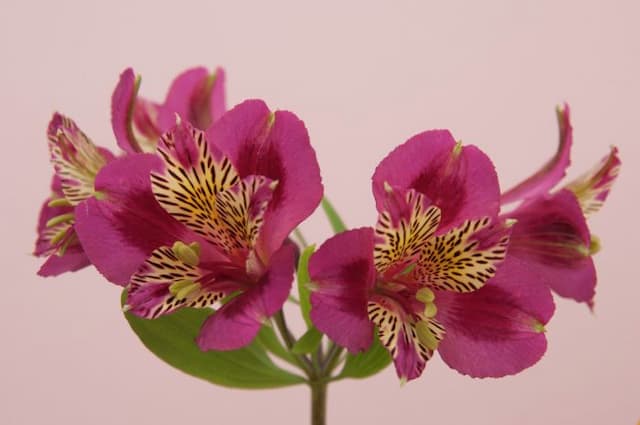Peruvian Lily Alstroemeria 'Polka'

ABOUT
The Alstroemeria 'Polka', commonly known as the Peruvian Lily or Lily of the Incas, is a striking and vibrant flowering plant. This particular variety is notable for its beautiful blooms that display a unique and eye-catching color combination. The flowers are characterized by a soft apricot-pink hue paired with a creamy yellow throat. Touches of dark brown or burgundy streaks elegantly accent the petals, creating a striking contrast against the lighter shades. These blooms are often funnel-shaped, with each petal exhibiting a slight twist that adds to the intricate visual texture. The foliage of the Peruvian Lily 'Polika' adds to the plant's aesthetic, as it consists of lush, green leaves that are typically lance-shaped, providing a dense and verdant backdrop for the colorful flowers. The leaves may also have a slim profile, and they gracefully arch away from the central stalk of the plant. This combination of stunning flowers and appealing foliage makes the Alstroemeria 'Polka' a popular choice for both gardens and floral arrangements, as it adds a touch of elegance and exotic charm wherever it is placed.
About this plant
 Names
NamesFamily
Alstroemeriaceae
Synonyms
Peruvian Lily, Lily of the Incas, Parrot Lily
Common names
Alstroemeria 'Polka'
 Toxicity
ToxicityTo humans
The Peruvian Lily (Alstroemeria 'Polka') is considered to have low toxicity to humans. Nevertheless, if ingested, parts of the plant can cause mild gastrointestinal upset, including nausea, vomiting, or diarrhea. Handling the plant may cause skin irritation or an allergic reaction in some individuals as well due to the sap.
To pets
The Peruvian Lily is mildly toxic to cats and dogs. If your pet ingests this plant, they might experience mild gastrointestinal upset, which could include symptoms such as vomiting or diarrhea. It's essential to monitor your pet and consult with a veterinarian if they show signs of distress after eating any part of the plant.
 Characteristics
CharacteristicsLife cycle
Perennials
Foliage type
Deciduous
Color of leaves
Green
Flower color
Pink
Height
2-3 feet (60-90 cm)
Spread
1-2 feet (30-60 cm)
Plant type
Herb
Hardiness zones
7
Native area
South America
Benefits
 General Benefits
General Benefits- Long Flowering Season: Alstroemeria 'Polka' blooms profusely from early summer until the first frosts, providing a long-lasting display.
- Attractive Flowers: It produces showy, pink and cream flowers that add aesthetic appeal to gardens and bouquets.
- Low Maintenance: Once established, it requires minimal upkeep, making it suitable for busy gardeners or those preferring low-maintenance plants.
- Drought Tolerance: This plant is relatively drought-tolerant, which is beneficial in areas with water restrictions or dry climates.
- Pollinator Friendly: The flowers attract bees, butterflies, and other pollinators, supporting local ecosystems.
- Versatile Uses: It's great for cut flower arrangements and can also be planted in borders, pots, or as part of a mixed flower bed.
 Medical Properties
Medical PropertiesThis plant is not used for medical purposes.
 Air-purifying Qualities
Air-purifying QualitiesThis plant is not specifically known for air purifying qualities.
 Other Uses
Other Uses- Alstroemeria 'Polka', commonly known as Peruvian lily, can be used in culinary presentations as an edible garnish due to its vibrant colors, though the plant itself is not edible.
- In photography and art, the striking patterns and colors of Peruvian lily petals provide a natural subject for macro photography and botanical illustrations.
- As a natural dye source, the pigments from Peruvian lily petals can be used to create natural dyes for fabrics and crafts, offering hues of orange, yellow, and red.
- The distinctive markings and structure of Peruvian lily blooms inspire patterns and motifs in textile and wallpaper designs, bringing a floral aesthetic to interior decor.
- Floral foam sculptures often incorporate Peruvian lilies to add a splash of color and intricate detail to three-dimensional art pieces in floral arrangement competitions.
- The longevity of Peruvian lily cut flowers makes them suitable for long-term craft projects, such as dried flower arrangements or potpourri.
- In eco-friendly burial arrangements, Peruvian lilies provide a biodegradable alternative to traditional synthetic flowers.
- Due to their symbol of friendship and devotion, Peruvian lilies are used in crafting friendship bracelets and as motifs in stationery design, symbolizing a lasting bond.
- The structural complexity of the Peruvian lily is studied by botanists and horticulture students for educational purposes to understand plant morphology and hybridization.
- Peruvian lilies serve as inspiration for garden designers and landscape architects, who mimic their natural growth patterns in the design of public gardens and parks for aesthetic appeal and biodiversity.
Interesting Facts
 Feng Shui
Feng ShuiThe Alstroemeria, commonly known as the Peruvian Lily, is not used in Feng Shui practice.
 Zodiac Sign Compitability
Zodiac Sign CompitabilityThe Peruvian Lily is not used in astrology practice.
 Plant Symbolism
Plant Symbolism- Friendship: Alstroemeria, commonly known as Peruvian Lily or Lily of the Incas, often symbolizes enduring friendship due to its long-lasting blooms and the way its flowers are twisted, which represents the ups and downs of friendships.
- Devotion: The Peruvian Lily symbolizes a strong commitment and devotion between individuals, making it an ideal gift for a close friend or loved one to express steadfastness.
- Prosperity: With its multiple flowers on each stem, the Peruvian Lily is often associated with wealth and prosperity, reflecting an abundance of blessings.
- Achievement and Success: As the Peruvian Lily grows and flourishes in many conditions, it can also represent personal growth, achievement, and the success that comes from hard work.
 Water
WaterPeruvian Lilies prefer to have their soil consistently moist but not waterlogged. During the growing season, water when the top inch of the soil feels dry to the touch, which typically means watering once or twice a week, depending on climate conditions. Provide each plant with approximately 24 ounces of water at each watering session. Reduce watering frequency in the cooler months when the plant is not actively growing, ensuring the soil doesn't dry out completely. Peruvian Lilies are somewhat drought-tolerant but perform best with regular watering.
 Light
LightPeruvian Lilies thrive in bright, indirect sunlight but can also tolerate partial shade. The ideal location for these plants is a spot where they receive morning sunlight and afternoon shade, which helps protect them from the intense heat of the day. Too much direct sunlight can lead to leaf burn, so filtered light is ideal for the healthiest growth.
 Temperature
TemperaturePeruvian Lilies do best in temperatures between 65°F and 80°F, which are ideal conditions for robust growth. They can survive brief periods of colder weather down to about 23°F but should be protected from hard frosts. High temperatures above 90°F may cause the plants to go dormant, so it's best to provide some shade during the hottest parts of the summer.
 Pruning
PruningPeruvian Lilies should be pruned to remove spent flowers and encourage further blooming throughout the growing season. After a bloom fades, gently pull the entire flower stem from the base to promote new growth. This helps maintain the plant's vigor and appearance. The best time for more extensive pruning is late winter or early spring, just before new growth begins.
 Cleaning
CleaningAs needed
 Soil
SoilThe Peruvian Lily thrives in fertile, well-draining soil with a pH between 6.5 and 7.5. A mix of loam, compost, and sharp sand or perlite is ideal to ensure proper drainage and fertility.
 Repotting
RepottingPeruvian Lilies, like 'Polka', typically need repotting every two to three years or when they become root-bound.
 Humidity & Misting
Humidity & MistingPeruvian Lilies prefer moderate to high humidity levels, but they are fairly adaptable to average household humidity conditions.
 Suitable locations
Suitable locationsIndoor
Ensure bright indirect light, well-draining soil, and consistent watering for indoor Peruvian Lilies.
Outdoor
Plant in partial shade, protect from strong winds, and ensure rich, well-drained soil for outdoor Peruvian Lilies.
Hardiness zone
7-10 USDA
 Life cycle
Life cycleThe Alstroemeria 'Polka', commonly known as the Peruvian Lily 'Polka', begins its life cycle as a tuberous rhizome, which upon planting in well-draining soil and with the right conditions, will sprout into a seedling. It matures into a lush, herbaceous plant, producing long, lance-shaped leaves and sturdy stems. The Peruvian Lily 'Polika' reaches its flowering stage, during which it displays its characteristic trumpet-shaped flowers, with striking pink and cream hues and distinctive flecking. After the flowering period, which can last from late spring through early fall, the plant enters a dormant stage, especially in colder climates where it dies back to the ground. During dormancy, the underground rhizomes store energy for the next growing season. The plant completes its cycle by regenerating from the rhizomes each spring, continuing to grow and reproduce through division or the production of new rhizomes.
 Propogation
PropogationPropogation time
Spring-Early Summer
Propogation: The Peruvian Lily, known botanically as Alstroemeria 'Polka', is commonly propagated through division, which is the most popular and effective method for this plant. The best time for dividing Peruvian Lilies is in the early spring or late fall when the plant is not actively blooming. To propagate by division, carefully dig up the clump of tubers and rhizomes being sure not to damage the roots. Gently separate the clumps into smaller sections, each with at least one growth point or "eye." These sections can then be replanted immediately in well-draining soil, spaced about 12 to 24 inches apart, which is equivalent to approximately 30 to 60 centimeters. Water the newly planted divisions thoroughly to help establish them. Division not only helps propagate new plants but also rejuvenates older clumps that may have become too dense, thereby promoting better growth and flowering.





![Peruvian lily [H.R.H. Princess Alice]](/_next/image?url=https%3A%2F%2Fplants-admin.emdemapps.com%2Fimages%2Fplants%2F%2Fimages%2F604b55e81c8b0.png&w=640&q=75)

![Peruvian lily [Inca Coral]](/_next/image?url=https%3A%2F%2Fplants-admin.emdemapps.com%2Fimages%2Fplants%2F%2Fimages%2F604b5b79b85ce.png&w=640&q=75)
![Peruvian lily [Inca Exotica]](/_next/image?url=https%3A%2F%2Fplants-admin.emdemapps.com%2Fimages%2Fplants%2F%2Fimages%2F604b5ec0e34a9.png&w=640&q=75)
![Peruvian lily [Inca Milk]](/_next/image?url=https%3A%2F%2Fplants-admin.emdemapps.com%2Fimages%2Fplants%2F%2Fimages%2F604b5f14b0b6a.png&w=640&q=75)